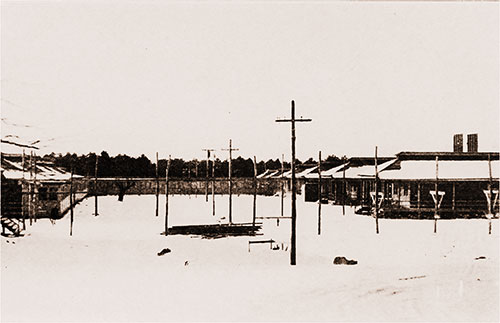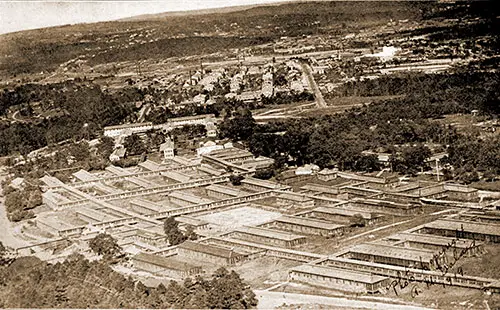The Medical Corps at Camp Devens

Barrack's Base Hopital, Camp Devens Decribed and Photographed, 1918. GGA Image ID # 18cdf04bd3
Since the Red Cross has come under the War Department's dominion, the ambulances and equipment have become adjuncts to the Medical Corps, and the workers enlisted men in the army.
The Medical Corps at Camp Devens is under the direction of Lieutenant- Colonel Powell, the divisional surgeon, who has under him, 230 officers and 1100 men.
Besides the base hospital, there are twenty-six infirmaries attached to the regimental units for the most part. Each of these smaller hospitals has a staff of officers and trained men to take care of the trivial cases or administer first aid upon an emergency.
After breakfast, the men who are not well answer "sick-call" and are marched by a non-commissioned officer to the regimental infirmary each morning.
If their illnesses are imaginary or obviously only temporary, the staff treats them there; any men whose condition is not normal, or who might develop sickness through lack of proper care, are sent to the base hospital in ambulances.
It lends a touch of realism to the camp's ordinary commonplace incidents to see these ambulances, with large red crosses on the side, go tearing along the road.
The "rolling stock" of the Medical Corps consists of thirty ambulances like those illustrated and four field hospitals. These vehicles' drivers belong to the four ambulance companies, whose quarters are adjacent to those of the Headquarters Train.
The picture shows three ambulances waiting near one of the regimental infirmaries for patients to take to the base hospital.
History of Hospital at Camp Devens, Ayre, Massachusetts

View of the Base Hospital in the Foreground, and the Rest of Camp Devens in the Distance. Forging the Sword, 1920. GGA Image ID # 18cde55959
When the War Department decided to erect a cantonment in the Northeastern part of the United States for training conscripted soldiers to fight in Europe in World War I, The Army selected the town of Ayer for the site because of the contour of the land, the abundance of good water, the accessibility of modern railroad facilities, and the proximity of the coast in the event of an enemy attack.
The contractor (Fred T. Ley Company, Springfield, Mass.) began clearing the scrub oak and pine from the cantonment site on 19 June 1917. One week later, there Were 1489 Workmen at the site ready to erect living quarters for the men who were to be assigned to the cantonment for training as soldiers.
On 25 June 1917, the first medical officer arrived at the campsite to work with the contractor. His name was Captain Glen I. Jones, and he had the title of "Sanitation Officer."
On Tuesday, 28 August 1917, the first large group of medical personnel arrived at Fort Benjamin Harrison, Ind. They were members of a sanitary corps detachment, and there Were 38 officers and 240 enlisted men in the unit.
The commanding officer was Captain George Waters. On Sunday, 15 July 1917, the cantonment site was named Camp Devens, after a native Son, Major General Charles Devens, a hero of the Civil War, Attorney General of the United States in President Rutherford B. Hayes' Cabinet.
The first permanent Army hospital at Camp Devens opened on 1 September 1917 with 46 of its 59 ward buildings completed. It was designated Camp Base Hospital and was commanded by Major Glen I. Jones. (The first medical officer assigned to the camp in June.)
It was initially planned as a 1600 bed hospital. By December 1917, it had grown to a 2740 bed hospital, making it the 7th largest of the 35 camp hospitals then in existence in the United States and the 12th largest of all the U.S. Army hospitals throughout the country.
The first patient admitted to the hospital with the dreaded "flu" occurred on Tuesday, 27 August 1918. By the end of the day, six more men were admitted with the same symptoms.
By 14 September, there were 1765 cases of flu in the hospital, and four days later, the number had climbed to 7400 with 68 deaths. The hospital was staffed with 210 nurses at the start of the flu epidemic, but as the number of patients increased, the Army rushed nurses and doctors to Devens from Army posts all over the country.
Twelve thousand seven hundred seven cases were reported by 30 September, with 593 deaths attributed to the flu. The disease had disabled 14,280 servicemen by 8 October, and the death toll had risen to 775, including two doctors and five nurses.
Camp Devens was the hardest hit of all the military installations in the United States. The flu started to wane on 8 October, and two days later, the post lifted all quarantines and restrictions. Wounded soldiers from the fighting in France began arriving at Devens on 1 December for treatment and rehabilitation.
The Camp Base Hospital at Devens was staffed with 940 medical corpsmen making it 5th in numbers of enlisted personnel assigned of all 35 camp base hospitals in the United States. With 146 officers on the hospital staff, Devens hospital rated number 2 in the country in the number of medical officers assigned.
